As with all style 'rules' in Counterpointer, each of these can be turned on or off as needed to produce the desired style. They are available in the Set Style window when doing Free Counterpoint.
A pitch is 'dissonant' if it forms an unstable interval with other pitches. Stable or consonant intervals are the octave, fifth, thirds and sixths. Unstable or dissonant intervals are the others: seconds, sevenths, and particularly the augmented 4th and diminished 5th. Any augmented or diminished interval will also be considered dissonant in part-writing, though some of these (e.g. the diminished fourth) actually sound, on a piano, the same pitches as consonant intervals. The octave and the fifth are known as "perfect consonances" and the thirds and sixths are "imperfect consonances."
![]() Treat the 3rd and 6th as
dissonant (could be used for a very early polyphonic style). This option is
provided just for the fun of it. Early music theorists thought in terms of scales
tuned by a series of perfect fifths, in which the thirds and sixths sounded harsh,
and consequently did not regard these intervals as perfect enough for points of
rest, but merely something to be passed through on the way to a perfect consonance.
If you select this option thirds and sixths will join the ranks of dissonances,
and will require the kind of approach and departure expected of dissonances.
Treat the 3rd and 6th as
dissonant (could be used for a very early polyphonic style). This option is
provided just for the fun of it. Early music theorists thought in terms of scales
tuned by a series of perfect fifths, in which the thirds and sixths sounded harsh,
and consequently did not regard these intervals as perfect enough for points of
rest, but merely something to be passed through on the way to a perfect consonance.
If you select this option thirds and sixths will join the ranks of dissonances,
and will require the kind of approach and departure expected of dissonances.
![]() Treat the P 4th with bass as
dissonant. This option is normally set, but could be turned off to create an
archaic style. The perfect fourth is unique among the intervals in that it is
treated sometimes as a dissonance and sometimes as a consonance. When formed with
the bass it is normally considered dissonant. There is a special case called the "consonant fourth,"
about which you'll see more below.
Treat the P 4th with bass as
dissonant. This option is normally set, but could be turned off to create an
archaic style. The perfect fourth is unique among the intervals in that it is
treated sometimes as a dissonance and sometimes as a consonance. When formed with
the bass it is normally considered dissonant. There is a special case called the "consonant fourth,"
about which you'll see more below.
![]() Treat the Aug 4 and Dim 5 as
consonant if not involving bass. In three or more parts it may be acceptable
to treat these dissonances more freely in the upper voices. This exception accounts
for the tradition in tonal music of writing the diminished triad in first inversion.
If you want to treat these intervals as consonant even in two parts if they imply
a diminished triad or dominant seventh chord, use the option to allow free use of
"essential" dissonances (bottom of this page). That would be appropriate only in
tonal counterpoint.
Treat the Aug 4 and Dim 5 as
consonant if not involving bass. In three or more parts it may be acceptable
to treat these dissonances more freely in the upper voices. This exception accounts
for the tradition in tonal music of writing the diminished triad in first inversion.
If you want to treat these intervals as consonant even in two parts if they imply
a diminished triad or dominant seventh chord, use the option to allow free use of
"essential" dissonances (bottom of this page). That would be appropriate only in
tonal counterpoint.
![]() The minor and diminished seventh of a chord
will be considered essential. All exceptions for essential dissonances so far apply just to the
diminished fifth or augmented fourth formed in the diminished triad. With this option that freedom is
extended to chords that use a minor seventh (such as the dominant seventh chord and the minor seventh
chord) or a diminished seventh. Examples:
The minor and diminished seventh of a chord
will be considered essential. All exceptions for essential dissonances so far apply just to the
diminished fifth or augmented fourth formed in the diminished triad. With this option that freedom is
extended to chords that use a minor seventh (such as the dominant seventh chord and the minor seventh
chord) or a diminished seventh. Examples:
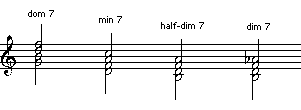
![]() Allow essential tones to dissonate freely with
other essential tones. Dissonances lying outside the prevailing harmony will still require appropriate handling.
Allow essential tones to dissonate freely with
other essential tones. Dissonances lying outside the prevailing harmony will still require appropriate handling.
![]() Permit no dissonance (as in
first species exercises). This really is useful only in the case of First Species
exercises.
Permit no dissonance (as in
first species exercises). This really is useful only in the case of First Species
exercises.
 Allow essential dissonances.
Allow essential dissonances.
![]() No leap to dissonance.
If checked, a leap to dissonance will be allowed only if the instance meets one of
the following exceptions.
No leap to dissonance.
If checked, a leap to dissonance will be allowed only if the instance meets one of
the following exceptions.
 Allow unaccented leap
to anticipation. An anticipation is an unaccented (metrically weak) note that
while dissonant itself anticipates a following accented consonance on the same pitch.
Usually it is approached by a downward second, but if you check this box a leap will
be permitted:
Allow unaccented leap
to anticipation. An anticipation is an unaccented (metrically weak) note that
while dissonant itself anticipates a following accented consonance on the same pitch.
Usually it is approached by a downward second, but if you check this box a leap will
be permitted:

 Allow if leap is between
essential tones. That is, allow if both notes are part of the sounding harmony.
That would include chords such as the diminished triad and the dominant seventh chord,
which contain dissonant intervals. Another way to allow this is to check the box at the
bottom of this window that permits essential tones to freely dissonate with other essential
tones. But that allows more leeway than this exception by itself.
Allow if leap is between
essential tones. That is, allow if both notes are part of the sounding harmony.
That would include chords such as the diminished triad and the dominant seventh chord,
which contain dissonant intervals. Another way to allow this is to check the box at the
bottom of this window that permits essential tones to freely dissonate with other essential
tones. But that allows more leeway than this exception by itself.
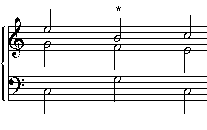
 Allow leap to dissonance
in cambiata. The cambiata is a figure that usually begins with a downward second to
an unaccented note, then a downward third followed by an upward second to another unaccented
note, so that it ends a third away from its beginning. Both the second and third notes can
be dissonant.
Allow leap to dissonance
in cambiata. The cambiata is a figure that usually begins with a downward second to
an unaccented note, then a downward third followed by an upward second to another unaccented
note, so that it ends a third away from its beginning. Both the second and third notes can
be dissonant.
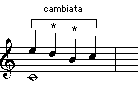
![]() Leap in cambiata must be downward.
The normal cambiata is formed with a downward leap, but if this box is not checked the
inverted cambiata will also be acceptable.
Leap in cambiata must be downward.
The normal cambiata is formed with a downward leap, but if this box is not checked the
inverted cambiata will also be acceptable.
 Allow appoggiatura.
The appoggiatura typically is formed by an upward leap to an accented dissonance, followed
by a downward stepwise resolution. This is one of the most satisfying of dissonances in
tonal counterpoint, but is not found in the Palestrina style.
Allow appoggiatura.
The appoggiatura typically is formed by an upward leap to an accented dissonance, followed
by a downward stepwise resolution. This is one of the most satisfying of dissonances in
tonal counterpoint, but is not found in the Palestrina style.

 Allow inverted appoggiatura.
The inverted appoggiatura deservedly does not get much respect. If allowed, the leap would be
downward, followed by an upward step:
Allow inverted appoggiatura.
The inverted appoggiatura deservedly does not get much respect. If allowed, the leap would be
downward, followed by an upward step:

 Allow unaccented appoggiatura.
This also is an unusual device, though less so than the inverted appoggiatura:
Allow unaccented appoggiatura.
This also is an unusual device, though less so than the inverted appoggiatura:

 Allow leap by the moving voice
in a suspension (with correct resolution of held voice). When dissonance is considered by
interval rather than by chord, both notes of the dissonant interval are of course equally dissonant.
So a suspension whose moving voice leaps to the downbeat could be seen as an instance of a leap
to dissonance. Check this box if you want the typical suspension to be available for use in modal
counterpoint. On the other hand, if you are allowing free treatment of essential dissonances
(dissonant tones that are part of the prevailing chord) then this exception is not required as
long as the harmony is clear.
Allow leap by the moving voice
in a suspension (with correct resolution of held voice). When dissonance is considered by
interval rather than by chord, both notes of the dissonant interval are of course equally dissonant.
So a suspension whose moving voice leaps to the downbeat could be seen as an instance of a leap
to dissonance. Check this box if you want the typical suspension to be available for use in modal
counterpoint. On the other hand, if you are allowing free treatment of essential dissonances
(dissonant tones that are part of the prevailing chord) then this exception is not required as
long as the harmony is clear.

![]() No simultaneous dissonance (do not begin
two dissonant notes simultaneously, though they can overlap). This rule is necessary for
enforcing Fourth Species counterpoint principles. Jeppeson observes (p. 153) that it derives
from the principle that in First Species (note against note) there can be no dissonance.
Strictly speaking, there are some exceptions for rapid notes.
No simultaneous dissonance (do not begin
two dissonant notes simultaneously, though they can overlap). This rule is necessary for
enforcing Fourth Species counterpoint principles. Jeppeson observes (p. 153) that it derives
from the principle that in First Species (note against note) there can be no dissonance.
Strictly speaking, there are some exceptions for rapid notes.
![]() No accented dissonances (below exceptions
can include those listed above for the appoggiatura). By accented we mean "metrically accented"
(see Fundamental Principles).
No accented dissonances (below exceptions
can include those listed above for the appoggiatura). By accented we mean "metrically accented"
(see Fundamental Principles).
 Allow suspension. Suspension
is the figure in which an unaccented consonant note (the 'preparation') is sustained onto a
downbeat at which it becomes dissonant in context and then resolves by step, normally downward.
This is a place for more exceptional treatment of the fourth: the fourth can be used as a consonant
preparation in a suspension if the bass of the fourth remains (letting that fourth resolve to a
third over the same bass). See Jeppeson, p. 193 ff. and
Kitson p. 117.
Allow suspension. Suspension
is the figure in which an unaccented consonant note (the 'preparation') is sustained onto a
downbeat at which it becomes dissonant in context and then resolves by step, normally downward.
This is a place for more exceptional treatment of the fourth: the fourth can be used as a consonant
preparation in a suspension if the bass of the fourth remains (letting that fourth resolve to a
third over the same bass). See Jeppeson, p. 193 ff. and
Kitson p. 117.
![]() Require preparation to be equal to or longer
than dissonance. That is, do not tie a shorter value to a longer one.
Require preparation to be equal to or longer
than dissonance. That is, do not tie a shorter value to a longer one.
 Allow delayed resolution.
Delayed or ornamental resolution of a suspension means that one or possibly more relatively brief
notes intervene between the dissonance and its normal downward resolution by step. Counterpointer
will be able to understand one note of delay if this option is checked.
Allow delayed resolution.
Delayed or ornamental resolution of a suspension means that one or possibly more relatively brief
notes intervene between the dissonance and its normal downward resolution by step. Counterpointer
will be able to understand one note of delay if this option is checked.
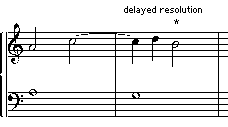
 Allow 'consonant fourth' preparation.
Though the fourth formed with the bass is normally considered dissonant, Palestrina and his contemporaries
accepted this very mild dissonance as preparation for a suspension in cases where the bass continues onto the following downbeat
and the fourth is approached by step. Not only can the fourth serve as its own preparation in this case, it
can also resolve a previous dissonance. This is discussed in Jeppeson(p. 193). who provides an example from
Palestrina and also supplies an example (p. 189) in which the consonant fourth resolves a dissonance.
Kitson (p. 117) mentions that Cherubini approved the consonant fourth but required that it be prepared by a
concord (i.e. he did not allow it to serve as resolution of a dissonance). Counterpointer goes with Jeppeson on this one.
Allow 'consonant fourth' preparation.
Though the fourth formed with the bass is normally considered dissonant, Palestrina and his contemporaries
accepted this very mild dissonance as preparation for a suspension in cases where the bass continues onto the following downbeat
and the fourth is approached by step. Not only can the fourth serve as its own preparation in this case, it
can also resolve a previous dissonance. This is discussed in Jeppeson(p. 193). who provides an example from
Palestrina and also supplies an example (p. 189) in which the consonant fourth resolves a dissonance.
Kitson (p. 117) mentions that Cherubini approved the consonant fourth but required that it be prepared by a
concord (i.e. he did not allow it to serve as resolution of a dissonance). Counterpointer goes with Jeppeson on this one.
The asterisk marks the consonant fourth in this example. Note that the bass repeats and the fourth is approached by step,
and that it also serves to resolve the previous seventh formed with the E in the middle voice.
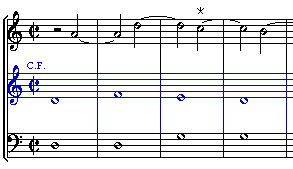
![]() Require preparation to be unaccented.
The preparation note is the unaccented consonant beginning of the tone that becomes dissonant on
the following metric accent. As seen above, this is the normal suspension.
Require preparation to be unaccented.
The preparation note is the unaccented consonant beginning of the tone that becomes dissonant on
the following metric accent. As seen above, this is the normal suspension.
 Allow "repeated note" suspension.
This is a suspension that is, so to speak, not suspended. The preparation and dissonance are
the same pitch but are not tied. This gives more prominence to the dissonance; it is not consistent
with the Palestrina style.
Allow "repeated note" suspension.
This is a suspension that is, so to speak, not suspended. The preparation and dissonance are
the same pitch but are not tied. This gives more prominence to the dissonance; it is not consistent
with the Palestrina style.
![]() Avoid using note of resolution in
dissonant sonority. At the moment of dissonance the pitch class of the resolution should not
be already present somewhere else in the sonority. In the following example the note of resolution
is C, already present in the middle voice.
Avoid using note of resolution in
dissonant sonority. At the moment of dissonance the pitch class of the resolution should not
be already present somewhere else in the sonority. In the following example the note of resolution
is C, already present in the middle voice.
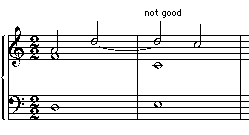
![]() Avoid upward resolution. Upward resolution
of a suspension is not typical of the Palestrina style.
Avoid upward resolution. Upward resolution
of a suspension is not typical of the Palestrina style.
![]() Avoid continued sixth in a 4-3 suspension
(continued 6th above lower tone). This is perhaps less technical than it sounds: in modern
harmonic terms it means that if you continue a sixth above the root in a 4-3 suspension you're
writing a 2nd inversion triad that moves to the harmony a third above its root - not a strong
harmonic movement (e.g. I 6/4 to iii6). In the Palestrina style the sixth would move to a fifth,
making in modern terms a strong I 6/4 to V.
Avoid continued sixth in a 4-3 suspension
(continued 6th above lower tone). This is perhaps less technical than it sounds: in modern
harmonic terms it means that if you continue a sixth above the root in a 4-3 suspension you're
writing a 2nd inversion triad that moves to the harmony a third above its root - not a strong
harmonic movement (e.g. I 6/4 to iii6). In the Palestrina style the sixth would move to a fifth,
making in modern terms a strong I 6/4 to V.
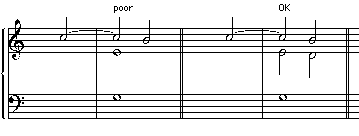
 Allow accented passing or neighbor
tones. Also known as "auxiliary tones" and "embellishments," these are tones usually found in
unaccented positions. A passing tone passes stepwise through a dissonance, either ascending or
descending. A neighboring tone also moves stepwise but returns to the note with which it began.
Allow accented passing or neighbor
tones. Also known as "auxiliary tones" and "embellishments," these are tones usually found in
unaccented positions. A passing tone passes stepwise through a dissonance, either ascending or
descending. A neighboring tone also moves stepwise but returns to the note with which it began.


![]() Allowed accented dissonances should resolve
to imperfect consonances (3rds or 6ths). This rule is consistent with 16th century practice:
a resolution to a 3rd or 6th is thought to heighten the effect of resolution.
Allowed accented dissonances should resolve
to imperfect consonances (3rds or 6ths). This rule is consistent with 16th century practice:
a resolution to a 3rd or 6th is thought to heighten the effect of resolution.
 Allow 9-8.
Allow 9-8.
 Allow 2-1.
Allow 2-1.
 Allow 4-5. Jeppeson (p.131)
allows no exceptions to the above rule, but Fux (Mann, p.57 ff.) does mention using the 9-8, 2-1,
and 4-5 as long as they are prepared in such a way as to avoid parallels:
Allow 4-5. Jeppeson (p.131)
allows no exceptions to the above rule, but Fux (Mann, p.57 ff.) does mention using the 9-8, 2-1,
and 4-5 as long as they are prepared in such a way as to avoid parallels:

![]() Allowed accented dissonances must be at least
one beat in value. In the Palestrina style accented dissonances are not found on quick notes.
Allowed accented dissonances must be at least
one beat in value. In the Palestrina style accented dissonances are not found on quick notes.
 Can be less if on a weak beat (e.g.
beat 2 or 4 in 4/4 or beat 2 in 2/2). Allowing for other styles - but this might seem confusing:
if the dissonance is on a weak beat how can it be accented? The answer is that it could still be
accented in relation to the following note. In a pair of eighth notes on the fourth beat, the
first eighth is accented with respect to the second one.
Can be less if on a weak beat (e.g.
beat 2 or 4 in 4/4 or beat 2 in 2/2). Allowing for other styles - but this might seem confusing:
if the dissonance is on a weak beat how can it be accented? The answer is that it could still be
accented in relation to the following note. In a pair of eighth notes on the fourth beat, the
first eighth is accented with respect to the second one.

![]() The upper tone of an accented 7th and lower
tone of an accented 2nd should resolve downward. That is, not only should an accented seventh
move to a sixth, but it should do so by letting the upper tone move down rather than by moving the
lower tone up. The lower tone of the second is of course the inverted seventh and would do the same thing.
The upper tone of an accented 7th and lower
tone of an accented 2nd should resolve downward. That is, not only should an accented seventh
move to a sixth, but it should do so by letting the upper tone move down rather than by moving the
lower tone up. The lower tone of the second is of course the inverted seventh and would do the same thing.
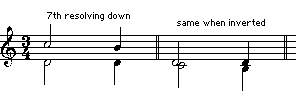
![]() Allow pedal tone dissonance (other notes can
freely dissonate with the pedal once it has begun). A pedal will be defined as a note that
lasts (or repeats) through more than six pitch changes in other voices. Really it would be better
to define it as a tone that is held through two or more changes of harmony, but for technical
reasons we'll make this arbitrary definition. A note meeting that description will, if this option
is set, be ignored when considering dissonance handling.
Allow pedal tone dissonance (other notes can
freely dissonate with the pedal once it has begun). A pedal will be defined as a note that
lasts (or repeats) through more than six pitch changes in other voices. Really it would be better
to define it as a tone that is held through two or more changes of harmony, but for technical
reasons we'll make this arbitrary definition. A note meeting that description will, if this option
is set, be ignored when considering dissonance handling.
![]() Pedal must be tonic or dominant. The pedal
is most often used on one of the two primary tones of the key, particularly the dominant.
Pedal must be tonic or dominant. The pedal
is most often used on one of the two primary tones of the key, particularly the dominant.
![]() Resolve dissonance immediately by
step. By 'immediately' we mean that the note following the dissonance must be consonant.
Resolve dissonance immediately by
step. By 'immediately' we mean that the note following the dissonance must be consonant.
 Allow escape tone. The escape
tone is an unaccented dissonance that is approached by step and left by downward leap:
Allow escape tone. The escape
tone is an unaccented dissonance that is approached by step and left by downward leap:

![]() Require escape to be downward.
Require escape to be downward.
 Allow cambiata. The classic
4-tone cambiata may violate both the leap from dissonance rule and the leap to dissonance rule
(see example above).
Allow cambiata. The classic
4-tone cambiata may violate both the leap from dissonance rule and the leap to dissonance rule
(see example above).
 Allow double auxiliary. The
double auxiliary looks like a cambiata but returns to the pitch on which it began. This is a
device not known in the Palestrina style (see Piston, p.57).
Allow double auxiliary. The
double auxiliary looks like a cambiata but returns to the pitch on which it began. This is a
device not known in the Palestrina style (see Piston, p.57).

 Allow indirect resolution of
fourth. This would not be appropriate in the Palestrina style, but may be seen in tonal
counterpoint, especially if instrumental. The pitch of resolution of the fourth (e in this case)
appears in the following sonority, but not in the same voice or octave:
Allow indirect resolution of
fourth. This would not be appropriate in the Palestrina style, but may be seen in tonal
counterpoint, especially if instrumental. The pitch of resolution of the fourth (e in this case)
appears in the following sonority, but not in the same voice or octave:

 Allow intervening essential tones before
resolution. This allows a stepwise resolution to be delayed by notes that are part of the prevailing
harmony. The F in this example resolves to E, but only after an intervening D that is part of the G7 chord:
Allow intervening essential tones before
resolution. This allows a stepwise resolution to be delayed by notes that are part of the prevailing
harmony. The F in this example resolves to E, but only after an intervening D that is part of the G7 chord:
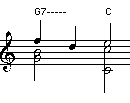
 Essential dissonance can serve as
resolution. If you are considering dissonance in harmonic terms then this option allows a
dissonance to be resolved by another dissonance if the second one is part of a chord. A chain of
seventh chords would be an example: in the below an essential B-F dissonance moves to an essential Bb-E,
then to A-Eb, and finally to a consonant Bb triad.
Essential dissonance can serve as
resolution. If you are considering dissonance in harmonic terms then this option allows a
dissonance to be resolved by another dissonance if the second one is part of a chord. A chain of
seventh chords would be an example: in the below an essential B-F dissonance moves to an essential Bb-E,
then to A-Eb, and finally to a consonant Bb triad.
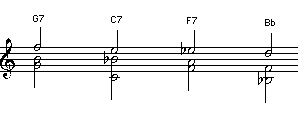
 Allow 2 successive dissonances if quick,
stepwise, in the same direction, and the first is unaccented. By 'quick' we mean less than a beat in value:
Allow 2 successive dissonances if quick,
stepwise, in the same direction, and the first is unaccented. By 'quick' we mean less than a beat in value:

 Allow 2 successive dissonances if
they are quick and stepwise. This allows the first to be in an accented position.
Allow 2 successive dissonances if
they are quick and stepwise. This allows the first to be in an accented position.

 Allow successive dissonance if the
second tone is an anticipation. Example:
Allow successive dissonance if the
second tone is an anticipation. Example:

![]() Avoid upper auxillary tones (upper neighbor tones).
Avoid upper auxillary tones (upper neighbor tones).
 Allow if note of return is longer.
Allow if note of return is longer.
![]() Avoid unaccented dissonance resolved by movement of a different voice. For example, a suspension is prepared by a consonance. If you prepare a suspension with a dissonance that then resolves to a consonance when the other dissonant voice moves, that would violate this rule.
Avoid unaccented dissonance resolved by movement of a different voice. For example, a suspension is prepared by a consonance. If you prepare a suspension with a dissonance that then resolves to a consonance when the other dissonant voice moves, that would violate this rule.
© 2011 Ars Nova Software, LLC